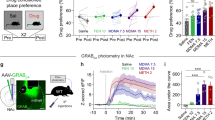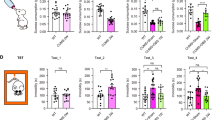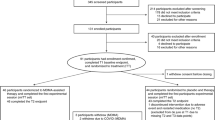Abstract
(+) 3,4,-Methylenedioxymethamphetamine (MDMA) is an abused drug that acutely releases serotonin (5-HT) and dopamine (DA) but produces long-term damage to 5-HT terminals. MDMA-induced DA release has been shown to be dampened by 5-HT. Although stress also activates the mesolimbic DA pathway, it is unknown if chronic stress after exposure to neurotoxic doses of MDMA will augment MDMA-induced DA release in the nucleus accumbens shell (NAcc(sh)). Rats were pretreated with MDMA (10 mg/kg × 4, intraperitoneal (i.p.)). After 7 days, rats were subjected to 10 days of chronic unpredictable stress. DA release in the NAcc(sh) and 5-HT in the ventral tegmental area (VTA) were measured after a challenge injection of MDMA (5 mg/kg, i.p.). The combination of pretreatment with MDMA+stress decreased basal concentrations of 5-HT in the VTA and DA in the NAcc(sh) and enhanced MDMA-stimulated DA release in the NAcc(sh). Pretreatment with MDMA or stress alone blunted MDMA-induced 5-HT release in the VTA. The augmentation of MDMA-induced DA release in rats pretreated with MDMA+chronic stress was attenuated by perfusion of the 5-HT1B antagonist, GR127935 into the VTA before the MDMA challenge injection. These results suggest that prior exposure to both MDMA and stress can produce a long-term augmentation in mesolimbic DA transmission and enhanced drug abuse vulnerability that is mediated, in part, by the 5-HT1B receptor in the VTA.
Similar content being viewed by others
Log in or create a free account to read this content
Gain free access to this article, as well as selected content from this journal and more on nature.com
or
References
Abercrombie ED, Keefe KA, DiFrischia DS, Zigmond MJ (1989). Differential effect of stress on in vivo dopamine release in striatum, nucleus accumbens, and medial frontal cortex. J Neurochem 52: 1655–1658.
Aguirre N, Galbete JL, Lasheras B, Del RJ (1995). Methylenedioxymethamphetamine induces opposite changes in central pre- and postsynaptic 5-HT1A receptors in rats. Eur J Pharmacol 281: 101–105.
Azmitia EC, Murphy RB, Whitaker-Azmitia PM (1990). MDMA (ecstasy) effects on cultured serotonergic neurons: evidence for Ca2(+)-dependent toxicity linked to release. Brain Res 510: 97–103.
Bankson MG, Yamamoto BK (2004). Serotonin-GABA interactions modulate MDMA-induced mesolimbic dopamine release. J Neurochem 91: 852–859.
Battaglia G, Yeh SY, O'Hearn E, Molliver ME, Kuhar MJ, de Souza EB (1987). 3,4-Methylenedioxymethamphetamine and 3,4-methylenedioxyamphetamine destroy serotonin terminals in rat brain: quantification of neurodegeneration by measurement of [3 H]paroxetine-labeled serotonin uptake sites. J Pharmacol Exp Ther 242: 911–916.
Bielajew C, Konkle AT, Merali Z (2002). The effects of chronic mild stress on male Sprague-Dawley and Long-Evans rats. I. Biochemical and physiological analyses. Behav Brain Res 136: 583–593.
Bland ST, Twining C, Watkins LR, Maier SF (2003). Stressor controllability modulates stress-induced serotonin but not dopamine efflux in the nucleus accumbens shell. Synapse 49: 206–208.
Broom SL, Yamamoto BK (2005). Effects of subchronic methamphetamine exposure on basal dopamine and stress-induced dopamine release in the nucleus accumbens shell of rats. Psychopharmacology (Berlin) 181: 467–476.
Cadoni C, Solinas M, Pisanu A, Zernig G, Acquas E, Di CG (2005). Effect of 3,4-methylendioxymethamphetamine (MDMA, ‘ecstasy’) on dopamine transmission in the nucleus accumbens shell and core. Brain Res 1055: 143–148.
Cameron DL, Williams JT (1994). Cocaine inhibits GABA release in the VTA through endogenous 5-HT. J Neurosci 14: 6763–6767.
Cameron DL, Williams JT (1995). Opposing roles for dopamine and serotonin at presynaptic receptors in the ventral tegmental area. Clin Exp Pharmacol Physiol 22: 841–845.
Carlezon Jr WA, Wise RA (1996). Rewarding actions of phencyclidine and related drugs in nucleus accumbens shell and frontal cortex. J Neurosci 16: 3112–3122.
Crespi D, Mennini T, Gobbi M (1997). Carrier-dependent and Ca(2+)-dependent 5-HT and dopamine release induced by (+)-amphetamine, 3,4-methylendioxymethamphetamine, p-chloroamphetamine and (+)-fenfluramine. Br J Pharmacol 121: 1735–1743.
Daniela E, Brennan K, Gittings D, Hely L, Schenk S (2004). Effect of SCH 23390 on (+/−)-3,4-methylenedioxymethamphetamine hyperactivity and self-administration in rats. Pharmacol Biochem Behav 77: 745–750.
De Deurwaerdere P, Navailles S, Berg KA, Clarke WP, Spampinato U (2004). Constitutive activity of the serotonin 2C receptor inhibits in vivo dopamine release in the rat striatum and nucleus accumbens. J Neurosci 24: 3235–3241.
de Vries P, Apaydin S, Villalon CM, Heiligers JP, Saxena PR (1997). Interactions of GR127935, a 5-HT(1B/D) receptor ligand, with functional 5-HT receptors. Naunyn Schmiedebergs Arch Pharmacol 355: 423–430.
Di Chiara G, Imperato A (1988). Drugs abused by humans preferentially increase synaptic dopamine concentrations in the mesolimbic system of freely moving rats. Proc Natl Acad Sci USA 85: 5274–5278.
Di Giovanni G, Di Matteo V, Di Mascio M, Esposito E (2000). Preferential modulation of mesolimbic vs nigrostriatal dopaminergic function by serotonin(2C/2B) receptor agonists: a combined in vivo electrophysiological and microdialysis study. Synapse 35: 53–61.
Di Matteo V, Di Giovanni G, Di Mascio M, Esposito E (1999). SB 242084, a selective serotonin 2C receptor antagonist, increases dopaminergic transmission in the mesolimbic system. Neuropharmacology 38: 1195–1205.
Doherty MD, Pickel VM (2000). Ultrastructural localization of the serotonin 2A receptor in dopaminergic neurons in the ventral tegmental area. Brain Res 864: 176–185.
Everitt BJ, Parkinson JA, Olmstead MC, Arroyo M, Robledo P, Robbins TW (1999). Associative processes in addiction and reward. The role of amygdala-ventral striatal subsystems. Ann NY Acad Sci 877: 412–438.
Eyerman DJ, Yamamoto BK (2005). Lobeline attenuates methamphetamine-induced changes in vesicular monoamine transporter 2 immunoreactivity and monoamine depletions in the striatum. J Pharmacol Exp Ther 312: 160–169.
Fon EA, Pothos EN, Sun BC, Killeen N, Sulzer D, Edwards RH (1997). Vesicular transport regulates monoamine storage and release but is not essential for amphetamine action. Neuron 19: 1271–1283.
Frey K, Kilbourn M, Robinson T (1997). Reduced striatal vesicular monoamine transporters after neurotoxic but not after behaviorally-sensitizing doses of methamphetamine. Eur J Pharmacol 334: 273–279.
Gerrits MA, Petromilli P, Westenberg HG, Di CG, van Ree JM (2002). Decrease in basal dopamine levels in the nucleus accumbens shell during daily drug-seeking behaviour in rats. Brain Res 924: 141–150.
Gervais J, Rouillard C (2000). Dorsal raphe stimulation differentially modulates dopaminergic neurons in the ventral tegmental area and substantia nigra. Synapse 35: 281–291.
Gratton A, Wise RA (1994). Drug- and behavior-associated changes in dopamine-related electrochemical signals during intravenous cocaine self-administration in rats. J Neurosci 14: 4130–4146.
Gudelsky GA, Nash JF (1996). Carrier-mediated release of serotonin by 3,4-methylenedioxymethamphetamine: implications for serotonin-dopamine interactions. J Neurochem 66: 243–249.
Haile CN, GrandPre T, Kosten TA (2001). Chronic unpredictable stress but not predictable stress, enhances the sensitivity to the behavioral effects of cocaine in rats. Psychopharmacology 154: 213–220.
Hansen JP, Riddle EL, Sandoval V, Brown JM, Gibb JW, Hanson GR et al (2002). Methylenedioxymethamphetamine decreases plasmalemmal and vesicular dopamine transport: mechanisms and implications for neurotoxicity. J Pharmacol Exp Ther 300: 1093–1100.
Herman JP, Adams D, Prewitt C (1995). Regulatory changes in neuroendocrine stress-integrative circuitry produced by a variable stress paradigm. Neuroendocrinology 61: 180–190.
Hoebel BG (1985). Brain neurotransmitters in food and drug reward. Am J Clin Nutr 42: 1133–1150.
Johnson MP, Conarty PF, Nichols DE (1991). [3H]monoamine releasing and uptake inhibition properties of 3,4-methylenedioxymethamphetamine and p-chloroamphetamine analogues. Eur J Pharmacol 200: 9–16.
Kalivas PW, Duffy P (1995). Selective activation of dopamine transmission in the shell of the nucleus accumbens by stress. Brain Res 675: 325–328.
Katz RJ, Roth KA, Carroll BJ (1981). Acute and chronic stress effects on open field activity in the rat: implications for a model of depression. Neurosci Biobehav Rev 5: 247–251.
Koch S, Galloway MP (1997). MDMA induced dopamine release in vivo: role of endogenous serotonin. J Neural Transm 104: 135–146.
Koob GF (1992). Drugs of abuse: anatomy, pharmacology and function of reward pathways. Trends Pharmacol Sci 13: 177–184.
Koob GF, Weiss F (1992). Neuropharmacology of cocaine and ethanol dependence. Recent Dev Alcohol 10: 201–233.
Kosten TR, Rounsaville BJ, Kleber HD (1986). A 2.5 year follow-up of depression, life crises, and treatment effects on abstinence among opioid addicts. Arch Gen Psychiatry 43: 733–738.
Laaris N, Le PE, Hamon M, Lanfumey L (1997). Stress-induced alterations of somatodendritic 5-HT1A autoreceptor sensitivity in the rat dorsal raphe nucleus--in vitro electrophysiological evidence. Fundam Clin Pharmacol 11: 206–214.
Lanfumey L, Pardon MC, Laaris N, Joubert C, Hanoun N, Hamon M et al (1999). 5-HT1A autoreceptor desensitization by chronic ultramild stress in mice. Neuroreport 10: 3369–3374.
Lopez JF, Chalmers DR, Little KY, Watson SJ (1998). Rsuglatino of serotoninlA, glucocorticoid, and mineralocorticoid receptor in rat and human hippocampus: implications for the neurobiology of depression. Biol Psychiatry 43: 547–573.
Mangiavacchi S, Masi F, Scheggi S, Leggio B, De Montis MG, Gambarana C (2001). Long-term behavioral and neurochemical effects of chronic stress exposure in rats. J Neurochem 79: 1113–1121.
Matuszewich L, Filon ME, Finn DA, Yamamoto BK (2002). Altered forebrain neurotransmitter responses to immobilization stress following 3,4-methylenedioxymethamphetamine. Neuroscience 110: 41–48.
Matuszewich L, Yamamoto BK (2003). Long-lasting effects of chronic stress on DOI-induced hyperthermia. Psychopharmacology 169: 169–175.
McCreary AC, Bankson MG, Cunningham KA (1999). Pharmacological studies of the acute and chronic effects of (+)-3, 4-methylenedioxymethamphetamine on locomotor activity: role of 5-hydroxytryptamine(1A) and 5-hydroxytryptamine(1B/1D) receptors. J Pharmacol Exp Ther 290: 965–973.
Morley KC, Cornish JL, Li KM, McGregor IS (2004). Preexposure to MDMA (‘Ecstasy’) delays acquisition but facilitates MDMA-induced reinstatement of amphetamine self-administration behavior in rats. Pharmacol Biochem Behav 79: 331–342.
Najavits LM, Gastfriend DR, Barber JP, Reif S, Muenz LR, Blaine J et al (1998). Cocaine dependence with and without PTSD among subjects in the National Institute on Drug Abuse Collaborative Cocaine Treatment Study. Am J Psychiatry 155: 214–219.
O'Dell LE, Parsons LH (2004). Serotonin1B receptors in the ventral tegmental area modulate cocaine-induced increases in nucleus accumbens dopamine levels. J Pharmacol Exp Ther 311: 711–719.
O'Hearn E, Battaglia G, de Souza EB, Kuhar MJ, Molliver ME (1988). Methylenedioxyamphetamine (MDA) and methylenedioxymethamphetamine (MDMA) cause selective ablation of serotonergic axon terminals in forebrain: immunocytochemical evidence for neurotoxicity. J Neurosci 8: 2788–2803.
Ortiz J, Fitzgerald LW, Lane S, Terwilliger R, Nestler E (1996). Biochemical adaptations in the mesolimbic dopamine system in response to repeated stress. Neuropsychopharmacology 14: 433–452.
Piazza PV, Le MM (1998). The role of stress in drug self-administration. Trends Pharmacol Sci 19: 67–74.
Pothos EN, Larsen KE, Krantz DE, Liu Y, Haycock JW, Setlik W et al (2000). Synaptic vesicle transporter expression regulates vesicle phenotype and quantal size. J Neurosci 20: 7297–7306.
Rhoads DL (1983). A longitudinal study of life stress and social support among drug abusers. Int J Addict 18: 195–222.
Scearce-Levie K, Viswanathan SS, Hen R (1999). Locomotor response to MDMA is attenuated in knockout mice lacking the 5-HT1B receptor. Psychopharmacology (Berlin) 141: 154–161.
Schmidt CJ (1987). Neurotoxicity of the psychedelic amphetamine, methylenedioxymethamphetamine. J Pharmacol Exp Ther 240: 1–7.
Schmidt CJ, Taylor VL (1988). Direct central effects of acute methylenedioxymethamphetamine on serotonergic neurons. Eur J Pharmacol 156: 121–131.
Series HG, Cowen PJ, Sharp T (1994). p-Chloroamphetamine (PCA), 3,4-methylenedioxy-methamphetamine (MDMA) and d-fenfluramine pretreatment attenuates d-fenfluramine-evoked release of 5-HT in vivo. Psychopharmacology (Berlin) 116: 508–514.
Shankaran M, Gudelsky GA (1999). A neurotoxic regimen of MDMA suppresses behavioral, thermal and neurochemical responses to subsequent MDMA administration. Psychopharmacology (Berlin) 147: 66–72.
Sotelo C, Cholley B, El MS, Gozlan H, Hamon M (1990). Direct immunohistochemical evidence of the existence of 5-HT1A autoreceptors on serotoninergic neurons in the midbrain raphe nuclei. Eur J Neurosci 2: 1144–1154.
Sprouse JS, Aghajanian GK (1987). Electrophysiological responses of serotoninergic dorsal raphe neurons to 5-HT1A and 5-HT1B agonists. Synapse 1: 3–9.
Willner P, Puscat R, Papp M (1992). Chronic mild stress-induced anhedonia: a realistic animal model of depression. Neurosci Biobehav Rev 16: 525–534.
Wilsnack SC, Vogeltanz ND, Klassen AD, Harris TR (1997). Childhood sexual abuse and women's substance abuse: national survey findings. J Stud Alcohol 58: 265–271.
Wise RA, Bozarth MA (1984). Brain reward circuitry: four circuit elements ‘wired’ in apparent series. Brain Res Bull 12: 203–208.
Wise RA (1984). Neural mechanisms of the reinforcing action of cocaine. NIDA Res Monogr 50: 15–33.
Wise RA, Bozarth MA (1985). Brain mechanisms of drug reward and euphoria. Psychiatr Med 3: 445–460.
Wise RA (1994). Cocaine reward and cocaine craving: the role of dopamine in perspective. NIDA Res Monogr 145: 191–206.
Wise RA, Newton P, Leeb K, Burnette B, Pocock D, Justice Jr JB (1995). Fluctuations in nucleus accumbens dopamine concentration during intravenous cocaine self-administration in rats. Psychopharmacology (Berlin) 120: 10–20.
Yamamoto BK, Nash JF, Gudelsky GA (1995). Modulation of methylenedioxymethamphetamine-induced striatal dopamine release by the interaction between serotonin and gamma-aminobutyric acid in the substantia nigra. J Pharmacol Exp Ther 273: 1063–1070.
Yamamoto BK, Pehek EA (1990). A functional heterogeneity of the rat striatum as measured by in vivo electrochemistry and microdialysis. Brain Research 506: 236–242.
Yan QS, Yan SE (2001a). Serotonin-1B receptor-mediated inhibition of [(3)H]GABA release from rat ventral tegmental area slices. J Neurochem 79: 914–922.
Yan QS, Yan SE (2001b). Activation of 5-HT(1B/1D) receptors in the mesolimbic dopamine system increases dopamine release from the nucleus accumbens: a microdialysis study. Eur J Pharmacol 418: 55–64.
Yan QS, Zheng SZ, Yan SE (2004). Involvement of 5-HT1B receptors within the ventral tegmental area in regulation of mesolimbic dopaminergic neuronal activity via GABA mechanisms: a study with dual-probe microdialysis. Brain Res 1021: 82–91.
Yan QS, Zheng SZ, Feng MJ, Yan SE (2005). Involvement of 5-HT1B receptors within the ventral tegmental area in ethanol-induced increases in mesolimbic dopaminergic transmission. Brain Res 1060: 126–137.
Zhang Y, Schlussman SD, Ho A, Kreek MJ (2003). Effect of chronic ‘binge cocaine’ on basal levels and cocaine-induced increases of dopamine in the caudate putamen and nucleus accumbens of C57BL/6J and 129/J mice. Synapse 50: 191–199.
Zucker M, Weizman A, Rehavi M (2005). Repeated swim stress leads to down-regulation of vesicular monoamine transporter 2 in rat brain nucleus accumbens and striatum. Eur Neuropsychopharmacol 15: 199–201.
Acknowledgements
This work was supported by DA 16866, DA16501, and a gift from Hitachi America Inc.
Author information
Authors and Affiliations
Corresponding author
Rights and permissions
About this article
Cite this article
Amato, J., Bankson, M. & Yamamoto, B. Prior Exposure to Chronic Stress and MDMA Potentiates Mesoaccumbens Dopamine Release Mediated by the 5-HT1B Receptor. Neuropsychopharmacol 32, 946–954 (2007). https://doi.org/10.1038/sj.npp.1301174
Received:
Revised:
Accepted:
Published:
Issue date:
DOI: https://doi.org/10.1038/sj.npp.1301174
Keywords
This article is cited by
-
NADPH oxidase elevations in pyramidal neurons drive psychosocial stress-induced neuropathology
Translational Psychiatry (2012)
-
Molecular and Cellular Mechanisms of Ecstasy-Induced Neurotoxicity: An Overview
Molecular Neurobiology (2009)
-
Neurotoxicity of substituted amphetamines: Molecular and cellular mechanisms
Neurotoxicity Research (2007)



